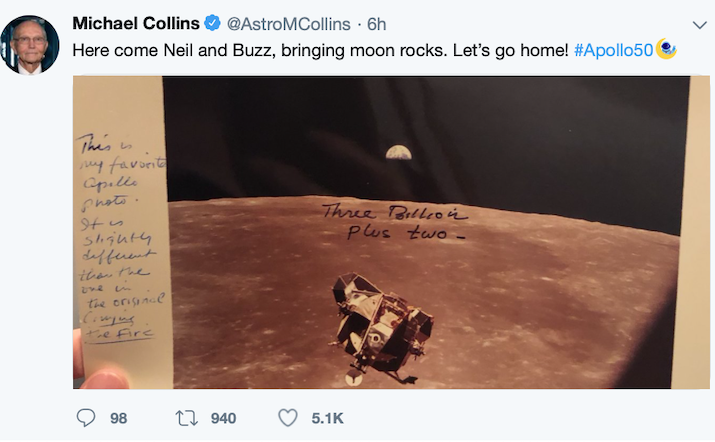
Michael Collins posted this photo July 21 on Twitter. It shows Apollo 11’s lunar module, lifting crew mates Neil Armstrong and Buzz Aldrin from the moon’s surface to rejoin the command module that Collins was piloting in lunar orbit. Collins’ inscription on the left calls it his “favorite Apollo photo.” The words “three billion plus two” on the picture refer to a statement he issued through NASA for Apollo 11’s 40th anniversary in 2009. In it, Collins said he didn’t feel “lonely or abandoned” while the other astronauts were on the moon, but he added: “I don’t mean to deny a feeling of solitude. It is there, reinforced by the fact that radio contact with the earth abruptly cuts off at the instant I disappear behind the moon. I am alone now, truly alone, and absolutely isolated from any known life. I am it. If a count were taken, the score would be three billion plus two over on the other side of the moon, and one plus God knows what on this side.”
By Bill Dawson
Texas Climate News
Christmas Eve last year was the 50th anniversary of one of history’s most famous photographs, Earthrise. Captured by astronaut Bill Anders as he and his two Apollo 8 crew mates orbited the moon, the image helped create a new environmental consciousness.
As TCN noted last December: “For many, it captured a sense of the planet’s preciousness and precariousness and is credited with playing a crucial role in catalyzing the modern environmental movement – and therefore with today’s growing concern about man-made disruption of the planet’s climate system.”
In an interview marking this weekend’s 50th anniversary of a far more momentous space flight – Apollo 11 – former astronaut Michael Collins said his view of Earth on that mission had a similar outlook-altering impact on him.
Collins, now 88 years old, piloted Apollo 11’s command module in lunar orbit while fellow voyagers Neil Armstrong and Buzz Aldrin descended aboard its lunar module to become the first humans to walk on the moon.
Collins recently told BBC’s Stephen Sackur how seeing Earth from that vantage point had transformed his outlook.
Sackur: “Did you find it changed your view of humanity, of our place in the universe?”
Collins: “Yes, I believe it did. If there is any part of the flight of Apollo 11 that sticks in my memory, it is the memory of a little tiny thing that you could obscure with your thumbnail, blue and white. The white clouds and blue of the ocean. Just a trace of land. Gorgeous, very shiny, bright. Background totally black. I will remember that all my life and it leaves one to consider, well, is it so pretty? Is it so quiet? Is it so pristine? For some reason, the word fragile came up out of the murk somehow. I know not how. But I thought, God it’s a fragile little thing, isn’t it?”
Sackur: “Well, in the 50 years since you had that special view of our planet, do you think we human beings have respected and understood that fragility?”
Collins: “No, no, I don’t think so. When we flew to the moon, the population of the earth was about two billion and it’s sneaking up now on eight billion. And that growth is willy-nilly, without any consideration for the support that that additional number of people requires from the resources of the earth. No, I don’t think we ever considered that.”
+++++
Bill Dawson is the founder and editor of Texas Climate News. He remembers watching the live television broadcast of Apollo 11 astronauts walking on the moon with his family in their Houston home.
